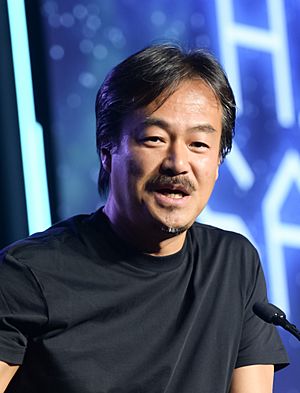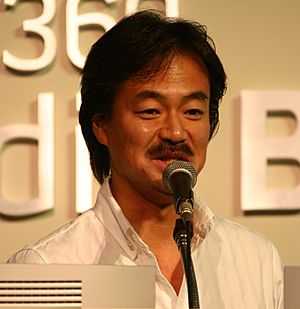Hironobu Sakaguchi facts for kids
Quick facts for kids
Hironobu Sakaguchi
|
|
|---|---|
| 坂口 博信 | |

Sakaguchi at the 2015 Game Developers Choice Awards
|
|
| Born | November 25, 1962 Hitachinaka, Ibaraki, Japan
|
| Occupation | CEO of Mistwalker, game designer |
| Employer | Square (1983–2003) Mistwalker (2004–present) |
| Known for | Role-playing video games |
|
Notable work
|
Final Fantasy Rad Racer Blue Dragon Terra Battle |
Hironobu Sakaguchi (坂口 博信, Sakaguchi Hironobu, born November 25, 1962) is a famous Japanese game designer, director, and producer. He is best known as the creator of the popular Final Fantasy series of video games.
Sakaguchi started his career at the company Square (which later became Square Enix) in 1983. After leaving Square in 2003, he started his own game studio called Mistwalker in 2004. At Mistwalker, he created other well-known games like the Blue Dragon series and Terra Battle.
Contents
Early Life and First Job
Hironobu Sakaguchi was born in Hitachinaka, Japan. As a kid, he enjoyed playing the piano and guitar. He even started a band with his friends in high school. At first, he wanted to be a musician and wasn't very interested in video games.
When he went to college, he studied computer science. His friend, Hiromichi Tanaka, had an Apple II computer. Sakaguchi played the game Wizardry on it and loved it so much that he often skipped class to play.
Sakaguchi wanted his own Apple II computer but couldn't afford one. He bought a cheaper, knockoff version instead. To buy games for his new computer, he needed a job. In 1983, he and Tanaka found part-time work at a new video game company called Square. Sakaguchi thought working at Square would be good practice for his programming skills while he still dreamed of becoming a musician.
Career
Working at Square (1983–2003)
At Square, Sakaguchi helped make a few games for computers. When the Nintendo Entertainment System (NES) came out, he made his first game for it, called King's Knight. Many of these early games were not big hits.
In 1986, Square became its own company, and Sakaguchi was hired as a full-time employee. That same year, a role-playing video game (RPG) called Dragon Quest became very popular. Sakaguchi convinced his bosses to let him make an RPG for Square, too.
The Creation of Final Fantasy
Sakaguchi's new RPG project was inspired by games like The Legend of Zelda and the Ultima series. At the time, he felt that if this game didn't sell well, he would quit the company and go back to college. Because of this feeling, he named the game Final Fantasy.
Luckily, Final Fantasy was a huge success. It sold 400,000 copies in Japan and launched the famous Final Fantasy series. Sakaguchi directed the next four games in the series. In 1991, he was promoted to Executive Vice President of Square. This new job meant he had less time to be directly involved in making games. Final Fantasy V was the last game in the series that he directed.
Famous Games and a Big Movie
Even with his new role, Sakaguchi still helped create amazing games. He was part of the "Dream Team" that made Chrono Trigger in 1995, working with the creator of Dragon Quest and the artist of Dragon Ball.
He was the producer for Final Fantasy VII, the first game in the series for the PlayStation. It was a massive hit all over the world. He also worked on other popular games like Final Fantasy Tactics and Parasite Eve.
Sakaguchi also had a big dream to make a movie. He directed a computer-animated film called Final Fantasy: The Spirits Within. The movie cost a lot of money to make, about $137 million. Unfortunately, it did not make enough money at the box office to cover its costs. This was a difficult time for Square and for Sakaguchi. After the movie's release, he decided to step back from his work at the company and officially left in 2003.
Starting Mistwalker (2004–present)

After leaving Square, Sakaguchi felt unmotivated for a few years. But after talking with some old friends, he was inspired to start making games again. In 2004, he founded his own studio, Mistwalker, with help from Microsoft.
Mistwalker's first few games were made for the Xbox 360 console. These included Blue Dragon and Lost Odyssey. He also directed The Last Story for the Wii, which was released in 2011.
After The Last Story, Sakaguchi decided to focus on making smaller games for mobile phones. His game Terra Battle was a big success. More recently, he created Fantasian, a beautiful RPG for the Apple Arcade service. Sakaguchi has said that because he is getting older, Fantasian might be his last major game.
Game Design and Ideas
Sakaguchi was very impressed by the first Dragon Quest game. It inspired him to create Final Fantasy. He loves tactical role-playing games and enjoys breaking rules to create something new and exciting. He has always wanted games to tell stories that are as powerful as movies.
One of Sakaguchi's rules for the Final Fantasy series was to never make direct sequels. He believed each game should be a complete story on its own.
A sad event in his life deeply affected his work. A fire at his family's home made him think a lot about life and death. These themes became very important in the stories of his games, including Final Fantasy VII and the movie The Spirits Within. He even named the main character of the movie, Aki Ross, after his mother.
Legacy and Influence
Sakaguchi has had a huge impact on the video game industry. He helped many other talented people at Square start their careers. These include the creators of the SaGa and Xeno series.
Even after he left Square, his influence remained. The creators of the Kingdom Hearts series said that a suggestion from Sakaguchi helped make the story more complex and interesting.
For his amazing work, Sakaguchi has received several major awards. In 2015, he was given a Lifetime Achievement Award at the Game Developers Choice Awards. People praised him for creating games with mature stories about important topics like loss and character growth.
Works
Video games
| Year | Title | Credit(s) |
|---|---|---|
| 1984 | The Death Trap | Game designer |
| 1985 | Will: The Death Trap II | |
| 1986 | Cruise Chaser Blassty | |
| King's Knight | ||
| 1987 | The 3-D Battles of WorldRunner | |
| Rad Racer | ||
| Nakayama Miho no Tokimeki High School | ||
| JJ: Tobidase Daisakusen Part II | ||
| Final Fantasy | Director, story | |
| 1988 | Final Fantasy II | |
| 1990 | Final Fantasy III | |
| 1991 | Final Fantasy IV | |
| 1992 | Final Fantasy V | |
| 1993 | Romancing SaGa 2 | Executive producer |
| 1994 | Final Fantasy VI | Producer, original story |
| 1995 | Front Mission | Supervisor |
| Chrono Trigger | ||
| Romancing SaGa 3 | Executive producer | |
| 1996 | Bahamut Lagoon | Supervisor |
| Front Mission: Gun Hazard | ||
| Super Mario RPG | Production supervisor | |
| Treasure Hunter G | General producer | |
| Tobal No. 1 | Supervisor | |
| 1997 | Final Fantasy VII | Producer, original story |
| Bushido Blade | Executive producer | |
| Tobal 2 | Supervisor | |
| Final Fantasy Tactics | Producer | |
| Front Mission 2 | Supervisor | |
| Chocobo's Mysterious Dungeon | Executive producer | |
| Einhänder | Supervisor | |
| 1998 | Xenogears | Executive producer |
| Bushido Blade 2 | ||
| Parasite Eve | Producer, concept | |
| Soukaigi | Supervisor | |
| Brave Fencer Musashi | Executive producer | |
| Ehrgeiz | Supervisor | |
| Chocobo's Dungeon 2 | Producer | |
| 1999 | Final Fantasy VIII | Executive producer |
| Chocobo Racing | ||
| SaGa Frontier 2 | ||
| Cyber Org | ||
| Legend of Mana | ||
| Front Mission 3 | ||
| Chrono Cross | ||
| Parasite Eve II | ||
| Chocobo Stallion | ||
| 2000 | Vagrant Story | |
| Driving Emotion Type-S | ||
| Final Fantasy IX | Producer, story | |
| The Bouncer | Executive producer | |
| 2001 | Final Fantasy X | |
| 2002 | Kingdom Hearts | |
| Final Fantasy XI | ||
| 2003 | Final Fantasy Tactics Advance | |
| Final Fantasy X-2 | ||
| 2006 | Final Fantasy XII | Executive producer, special thanks |
| Blue Dragon | Producer, Scenario, lyricist | |
| 2007 | ASH: Archaic Sealed Heat | Executive producer, scenario |
| Lost Odyssey | Scenario, lyricist | |
| 2008 | Blue Dragon Plus | Scenario |
| Away: Shuffle Dungeon | ||
| 2009 | Blue Dragon: Awakened Shadow | Executive director |
| 2011 | The Last Story | Director, scenario, lyricist |
| 2012 | Party Wave | Director, music, surfing |
| 2014 | Terra Battle | Producer |
| 2017 | Terra Battle 2 | |
| 2019 | Terra Wars | |
| 2021 | Fantasian | Producer, scenario, lyricist |
Films
| Year | Title | Credit(s) |
|---|---|---|
| 2001 | Final Fantasy: The Spirits Within | Director, producer, original story |
See also
 In Spanish: Hironobu Sakaguchi para niños
In Spanish: Hironobu Sakaguchi para niños

